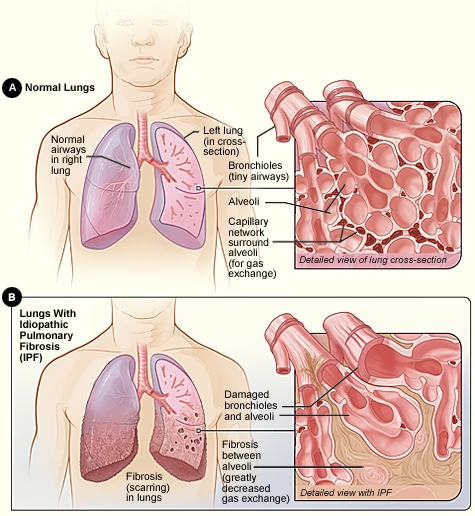Zakir Hussain, one of the most revered tabla maestros in the world, left a profound impact on the global music community. Known for his virtuosity, rhythm, and spiritual connection to the tabla, Hussain’s contributions to Indian classical music are unparalleled. However, the tragic news of his passing has raised questions surrounding his health, particularly the cause of his untimely death.
While Hussain’s brilliance on the tabla will forever be remembered, his battle with Idiopathic Pulmonary Fibrosis (IPF) sheds light on the silent struggles many face with this rare and chronic
lung disease. In this article, we delve into what IPF is, its impact on health, and the specific circumstances surrounding Zakir Hussain’s death, offering insights into how this condition can affect even the most talented individuals.
What is Idiopathic Pulmonary Fibrosis (IPF)?
Idiopathic Pulmonary Fibrosis (IPF) is a progressive lung disease characterized by the thickening and scarring of lung tissue. The term “idiopathic” refers to the fact that the cause of this fibrosis is unknown, though it is often associated with environmental factors, genetics, and age. As the disease progresses, it causes the lungs to lose their ability to exchange oxygen, leading to severe breathing difficulties.
In the early stages, the symptoms of IPF can be subtle, making it challenging to diagnose. Some common symptoms include:
- Shortness of breath, especially during physical exertion
- Dry, persistent cough
- Fatigue and weakness
- Unexplained weight loss
- Clubbing of fingers or toes (a condition where the tips of fingers or toes become rounded and enlarged)
Unfortunately, there is no known cure for IPF, and the disease often leads to respiratory failure. For those affected, the progression of the disease can be slow or rapid, and treatment mainly focuses on alleviating symptoms and slowing the progression of fibrosis.
Understanding the Impact of IPF on the Body
When IPF strikes, it leads to the gradual scarring of the lungs. This process, known as fibrosis, occurs when healthy tissue in the lungs is replaced by scar tissue, which cannot perform the function of healthy tissue. Over time, the scar tissue builds up, causing the lungs to become stiff and less capable of expanding and contracting.
This lack of lung elasticity makes it difficult for the individual to breathe properly. As fibrosis progresses, oxygen cannot be efficiently exchanged in the lungs, leading to hypoxemia (low oxygen levels in the blood). This results in shortness of breath, especially during physical activities that require greater lung capacity. In severe cases, pulmonary hypertension (high blood pressure in the lungs) can develop, adding to the strain on the heart and leading to eventual heart failure.
Zakir Hussain’s Battle with IPF
Zakir Hussain’s death was a shock to millions of his fans worldwide. The tabla legend was not only celebrated for his remarkable skill but also for his ability to innovate and collaborate with musicians across genres. However, behind his public persona, Zakir Hussain was fighting a silent battle with Idiopathic Pulmonary Fibrosis.
Details surrounding his diagnosis and personal struggles with IPF remain relatively private, as is often the case with many celebrities who choose to keep their health matters out of the public eye. However, his declining health in the months leading up to his death hinted at the severity of the condition. Like many with IPF, Zakir Hussain’s condition would have worsened over time, leading to increasing difficulty in performing and living with the disease.
While Zakir Hussain was known to continue performing despite his health challenges, the toll that IPF takes on the body could not be ignored. As the disease progresses, even the most accomplished individuals face limitations, particularly in activities that demand physical endurance and stamina, such as playing the tabla.
The Importance of Early Diagnosis and Treatment of IPF
One of the challenges with Idiopathic Pulmonary Fibrosis is the difficulty in diagnosing it early. The symptoms of IPF often mimic those of other lung diseases, which can lead to misdiagnosis or delayed treatment. However, early detection is crucial in slowing the progression of the disease and improving the patient’s quality of life.
Diagnosing IPF typically involves a combination of medical history, physical examination, pulmonary function tests, chest X-rays, and high-resolution CT scans. The CT scan, in particular, is useful for identifying the characteristic patterns of fibrosis in the lungs.
Treatment options for IPF are limited but can include:
- Antifibrotic medications such as pirfenidone or nintedanib, which can slow the progression of fibrosis
- Oxygen therapy to help maintain adequate oxygen levels in the blood
- Pulmonary rehabilitation to improve the physical stamina and quality of life
- Lung transplant in severe cases where the lungs fail to function adequately
Though no cure exists, these treatments can significantly improve symptoms and extend life expectancy, especially when initiated in the early stages of the disease.
Zakir Hussain’s Legacy and Health Awareness
While Zakir Hussain’s death is a tragic loss to the world of music, it also serves as a reminder of the importance of health awareness. His battle with Idiopathic Pulmonary Fibrosis highlights the challenges that come with a rare and progressive disease that is often diagnosed too late. The public’s response to his passing has sparked conversations about IPF and the impact it has on both patients and their families.
His death can serve as a catalyst for raising awareness about the disease, encouraging people to seek medical attention if they experience symptoms of lung disease, particularly those that persist over time. Additionally, the case of Zakir Hussain underscores the need for more research and attention to the disease, as well as advancements in treatments and cures.
The Role of Family and Support Systems in Managing IPF
For individuals diagnosed with Idiopathic Pulmonary Fibrosis, a strong support system is essential. While medical treatments are crucial, emotional and psychological support from family, friends, and caregivers plays a vital role in managing the challenges of living with the disease.
In the case of Zakir Hussain, it is likely that his family and close friends provided invaluable support as he dealt with the daily struggles of IPF. Having a network of people who understand the condition can help patients feel less isolated and provide them with the strength needed to manage their symptoms.
Additionally, joining support groups for those with IPF can offer individuals the chance to share their experiences, coping strategies, and emotional struggles. Support groups can also serve as a source of information about the latest research, treatments, and clinical trials.
How Can We Raise Awareness About IPF?
Raising awareness about Idiopathic Pulmonary Fibrosis is crucial in order to foster early detection and encourage research into more effective treatments. Here are some ways to increase awareness about IPF:
- Educational Campaigns: Public health campaigns that highlight the symptoms and risk factors of IPF can help individuals recognize the signs early and seek medical attention.
- Collaborations with Medical Professionals: Doctors and healthcare providers should educate patients about IPF, especially when they present symptoms that may indicate the presence of lung disease.
- Celebrity Advocacy: Like Zakir Hussain, other public figures who have dealt with IPF or similar conditions can use their platforms to shed light on the disease, making it a topic of public conversation.
- Research and Funding: Encouraging research into the causes, treatments, and potential cures for IPF is vital. Increased funding for IPF research can help accelerate the development of new therapies and improve the quality of life for those affected by the disease.
Conclusion: Honoring Zakir Hussain’s Memory Through Awareness
Zakir Hussain’s legacy as a tabla virtuoso is cemented in the annals of music history. However, his death due to Idiopathic Pulmonary Fibrosis serves as a reminder of the many individuals living with chronic, debilitating diseases. As we reflect on his life and music, we must also honor his memory by spreading awareness about IPF and its devastating effects.
While the world mourns the loss of a musical genius, we can also focus on the importance of early diagnosis, proper treatment, and supporting those affected by lung diseases. By doing so, we can ensure that the legacy of Zakir Hussain lives on, not just through his music, but also through the increased awareness and understanding of conditions like IPF.




